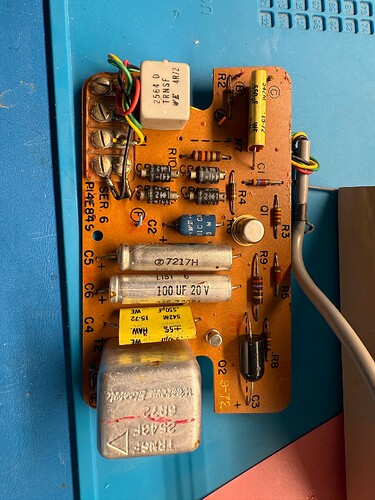I’m a fan of Severance, a show you’d find on Apple TV. Without really giving anything away, one of the recurring props in the show is something akin to an old Western Electric accessory speaker for your 500 series desk phone. The one on the show is a bit different, but the seed had been planted.
So, off to eBay I go, and about $40 later I have a real Bell System 107A speaker (you know it’s real, because it’s stamped with BELL SYSTEM PROPERTY - NOT FOR SALE on the bottom.) This thing was built in September 1972, based on the data code stamped on the bottom. Here’s what this baby looks like:
It is missing a knob, but I’ve plans to 3D print some translucent replacement (because, spoiler, RGB LEDs are involved.)
The original device comes with a PCB installed with a 2 transistor audio amplifer and a bunch of discrete components. Remember, vintage 1972… That (siingle-sided) PCB was removed, along with the volume control pot.
In it’s place is a small protoboard with an ESP32-WROVER module installed on it. I also replaced the volume control pot with a rotary encoder, because why not? There’s also an I2S decoder/amplifier with a 3 watt class D amplifier. It’s OK, especially since the 50 year old speaker was built to have an audio response tuned for toll-quality voice fidelity; about 300-3000 Hz. So plenty close enough for announcements, and just OK for playing music.
My rule is that if there’s an ESPHome based project being built, it’s got to have some blinkenlights as part of the project, usually one or more WS2812 RGB LEDs. The challenge here is that there are no openings that you can mount an LED on that are really visible from the outside. And I really don’t want to make external cosmetic changes to the speaker enclosure, so as to preserve that sweet vintage pre-AT&T divestiture design “style.” So I’ve mounted a couple of LEDs alongside the shaft of the rotary encoder, and I’m hoping that a translucent knob on the shaft will act as a light pipe. 2 LEDs so there can be some sort of motion effect; we’ll see how that works.
A USB cable is plugged into the ESP32 module, with a cable zip tie to act as strain relief.
I’m pleased with how this turned out; perhaps down the road, I’ll swap out the guts with a solution that includes microphone with a voice processing chip like in the Voice PE device. Curious to see how that ecosystem evolves over time with solutions that are a good fit for this (stupid) use-case. I’m pretty sure I’m much more amused by this than my wife is, but she’s used to that sort of thing.



